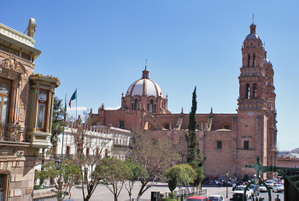
The Metropolitan Cathedral in Zacatecas.
From the time I arrived with my friend Clara to meet Javier in this state
capital city of 125,000 until the moment she and I reluctantly drove out of
town, we were delighted by everything we experienced in Zacatecas.
Three days were not nearly enough time to really savor its Colonial
pleasures. The simple 4-hour drive northeast from Guadalajara to Zacatecas
makes this trip one that we can repeat often—and we certainly want to
go again soon.
Founded in 1546, Zacatecas is a gorgeous Spanish-colonial city filled
with lively cultural activities. The spotless streets paved with lajas
(flat square cobblestones) twist and turn enticingly through the hilly
city, frequently ending at charming green pocket-size parks. The
climate is pleasant and the residents are helpful and welcoming. Street markets, color and music abound
and it seems as if there are art galleries and museums on every corner.
The rich silver mining history of the area oozes from every
architecturally splendid building.
In 1994, UNESCO (the United Nations Educational, Scientific, and
Cultural Organization), named Zacatecas a Cultural Patrimony of Mankind
site due to its architecture. The designation is richly deserved. The
elaborately carved pink cantera
(quarry stone) facades of churches and other buildings, the
intricate hand-wrought ironwork on balconies, door, and windows and the
brilliantly colored flowers blooming in pots and gardens throughout the
city make Zacatecas a visual feast.
The vibrant city of Zacatecas offers constant festivals of art,
music, film, and dance. We were there during an all-French film
festival which coincided with a classical music festival. In three
short days, the three of us attended a concert by the Zacatecas State
band, a free classical guitar concert performed by an
internationally-acclaimed soloist, and a book fair at a gorgeous Art
Deco period theater.
Friends had told us to take good walking shoes to Zacatecas. We were
glad we followed their advice, because for three days we were up and
down hilly cobbled streets, walking the sets of stairs that lead from
one level to another level in this city of fascinating nooks and
crannies.
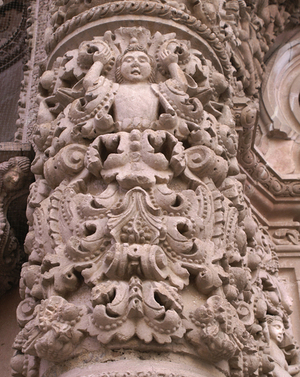
Detail of one carved column of the Cathedral.
We were glad we packed sweaters, too. It’s chilly in Zacatecas on winter
nights, although it’s warm and dry in the summer. Here in the heartland
of Mexico, dress is much more conservative than in the coastal areas
often frequented by foreigners. We quickly noticed that the tourists in
Zacatecas were chiefly Mexicans. Very little English is spoken in
museums, on the streets or in restaurants; we were glad that all of us
are fluent Spanish-speakers.
Zacatecas is approximately 8,000 feet above sea level in the
high desert region of Mexico, so some tourists experience shortness of
breath at first. It’s good to be initially wary of alcohol consumption.
At this altitude, alcohol hits hard until folks become accustomed to
the thin air.
Hotels and restaurants range from the humble to the luxurious. There are
plenty to choose from in every price range, from youth hostels to the
most elegant of digs. The most famous local hotel is the Quinta Real
Zacatecas. Architecturally stunning, this luxury hotel and its
surroundings are a must-see. Where else can you stay in a hotel that
lies alongside a 16th Century aqueduct and incorporates the oldest bull
ring in North America into its facility?
The interior of the hotel is truly impressive. Circling the
bull ring, hallways are boldly decorated and filled with a profusion of
potted plants and shrubs. You’ll find elegant boutiques around the
perimeter, with a prime spot reserved for a sophisticated restaurant.
Much as we loved the Quinta Real, my friends and I opted for
convenience and economy and stayed at the Hotel Posada Tolosa, located
just two blocks from the cathedral in the heart of the historic center.
Rooms here with two double beds are comfortably large and cost
approximately $60 USD per night. The room rate includes enclosed secure
parking. However, the hotel has no elevator and the stairs to
the rooms are steep.
Zacatecas has a great system of inexpensive public transportation: buses, combis (VW
bus-style taxis which follow a defined route) and private taxis. Any of
these vehicles can take tourists to outlying areas of interest. There’s
plenty of on-street parking if you’re visiting in a car, but the best
way to see the historic center of the city is on foot. All of the usual
tourist haunts are easy walking distance from the Cathedral, the heart
of the city.
La Bufa, which means the wineskin, is the name of the highest hill
overlooking the historic center of Zacatecas. Aptly named for its
distinct shape, the hill is the terminus of a fantastic teleférico
(cable rail) ride that lifts off near the El Edén mine entrance to sway
its way higher and higher over the city. The views are fantastic and at
the top there is a museum devoted to the Mexican revolution, complete
with larger-than-life-size statues of Francisco ‘Pancho’ Villa and
numerous other heroes and generals.
Every day of our stay we visited one of the many large museums and galleries for which Zacatecas is known.
The Pedro Coronel Museum is named for one of the foremost Mexican painters and sculptors of the 20th Century, and a zacatecano.
The massive and eclectic art collection of this older Coronel brother
(1923-1985), is housed in a huge colonial building which has been at
various times in its history a Jesuit college, a Dominican convent,
early military headquarters, and a jail. Room leads to room, and each
is filled with treasures.
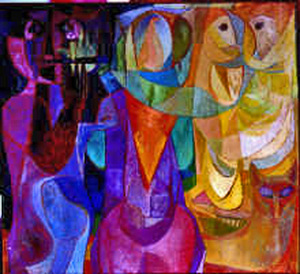
Pavana para una mujer embarazada, Pedro Coronel, 1959, oil on canvas, 184 x 202 cm. Private collection.
Coronel’s personal eclectic collection of Twentieth Century art is the
focus of the museum. Every modern artist from Braque to Miró to Picasso
is represented. Most were Coronel’s friends and contemporaries. We
devoured the glorious paintings. We spent only a morning here; to give
this museum its due, several mornings would be better.
The Rafael Coronel Museum, built in 1567 as a Franciscan
convent, is a superb example of colonial architecture at its finest. At
each turn in the building and everywhere on the grounds I found a
breathtaking opportunity to use my camera. The museum houses Rafael
Coronel’s collection of nearly 5,000 Mexican masks once used in dances
and traditional ceremonies. We marveled at the variety, the materials,
and the intricate artistry of the masks. Many of these masks were part
of Diego Rivera’s collection and were inherited by his daughter, who
married Rafael Coronel.
My favorite section of the museum was the magical collection of
19th Century Mexican puppets. The child in me adores antique dolls,
puppets, and other old toys.
The Francisco Goitia Museum is housed in the state
governor’s former mansion, located a longish walk or short cab ride
from the historic center of the city. Two huge rooms of the museum
house works by Zacatecas artists Julio Ruelas, Pedro and Rafael
Coronel, Manuel Felguérez and others. Another illustrious zacatecano,
Francisco Goitia (1882-1960) has been compared to the best European
painters. Several downstairs rooms are devoted to Goitia’s haunting
paintings. Up-and-coming younger Mexican artists are often invited to
exhibit in the second floor rooms.
When we visited the museum, two of the large upstairs rooms were
devoted to an exhibit of works by the best-known Mexican artists of the
first half of the 20th Century, including Diego Rivera, Rufino Tamayo,
and David Siquieros. This exhibit was on loan from the Museo de Arte Moderno in Mexico City.
To refuel for our next round of adventures, we happily hunted for—and
found—great food. We ate several meals at a landmark Zacatecas
restaurant, the Café Nevería Acropolis. It’s across the street from the
cathedral.
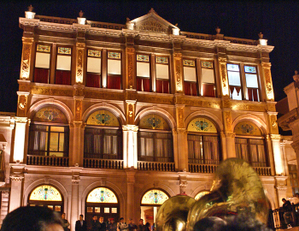
Teatro Calderón at night–the Zacatecas State Band is playing in the foreground.
This place bustles! From early morning till late at
night, the staff hops to keep up with the hordes of locals and tourists
who bring their need for sustenance to the café. Is it a Greek ice
cream parlor? Is it a Mexican restaurant/coffee shop? You be the judge.
Sit in a booth by the long windows on either side of the restaurant and
watch the town stroll by as you dine. Don’t miss the art on the
restaurant walls—original works by famous clients cover every available
space.
The menu is loaded with great Mexican breakfast, lunch and
dinner specialties plus a lengthy selection of pastries, cakes, pies,
and ice creams. I loved the cafe con leche (expresso coffee and hot milk). The fresh fruit salad with homemade yoghurt was delicious, as was the sopa azteca,
a spicy tomato-based broth loaded with fried tortilla strips, chunks of
ripe avocado, and thick cream topping. My companions raved about their
dinners. Clara chose enchiladas with cheese and chicken. Javier ordered
the chilaquiles (lightly fried tortilla strips, chicken, and onions basted in a red salsa picante
and topped with cream and a fried egg.) Both their offerings came with
rice, beans, and fresh hot tortillas. The prices were sure right! For
much less than $10 US per person we stoked our furnaces for another
night of festivities.
We ate one lunch at Doña Julia’s gorditas place, located
about a block and a half from the cathedral. Doña Julia is a real
person as well as a local institution. She has three or four tiny gorditas restaurants in Zacatecas and is the sponsor of an important athletic club. We loved the gorditas—they’re
a regional specialty of Zacatecas. Thick flour tortillas—cooked, split
and stuffed with a variety of savory treats—make an excellent breakfast
or lunch. Try the bean with cheese, or the pork, or the chicken.
They’re small—you can eat several. The skinny man at the next table ate
nine—we counted!
For a more formal meal, try the restaurant at the Hotel Quinta Real or
walk two blocks from the cathedral to Mi México or venture to the Mesón
de Jobita. Zacatecas is loaded with options for excellent food.
In Zacatecas, dancing in the streets is strongly encouraged. Every night we followed the callejonadas,
troupes of meandering street musicians who wander the city with an
entourage. Just before sundown every evening, a man with a burro and a
group of musicians appeared in front of our hotel. The bands usually
consisted of a couple of trumpets, a trombone, a saxophone and one or
two drums. A few people gathered around to listen, and then a few more.
Javier noticed that everyone had a tiny cup on a string around his or
her neck—and then suddenly we each had one too!
When the crowd was large enough, the musicians began strolling up
a callejón
(alleyway) playing razzmatazz music. Clara, Javier and I followed the
crowd up the narrow streets until we reached a charming tiny plaza. The
band struck up a dance tune, everyone danced with everyone else and the
fellow with the burro filled all of our little cups with aguamiel (a local tequila-like drink).
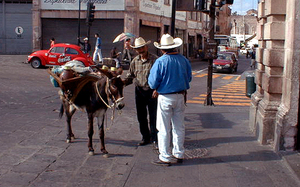
This little burro carries clay jugs of aguamiel, ready for the callejonadas.
That little burro was a four-legged bar! After we all had a little aguamiel
and a little dance time, the band led us around a corner and up another
alleyway, playing music all the way. A bit of dancing, a tad more aguamiel, some more marching along—until suddenly a couple of hours later
our heads spun from drink and dance and our cheeks ached from laughter.
The callejonadas are just the icing on the fabulous
cake that is Zacatecas. Our three-day visit wasn’t nearly long enough
to see and do all that we wanted. There is a variety of side trips that
we have in mind for our next journey: the town of Guadalupe to see the
museum of early colonial religious art, the town of Jerez and the 13th
Century ruins at La Quemada.
It won’t be long until I go back to Zacatecas. Let’s all go!
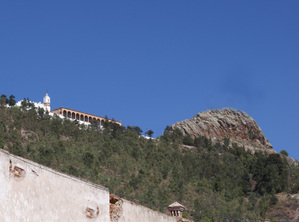
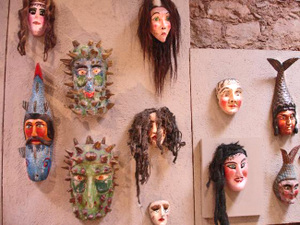
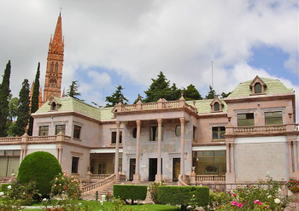
Leave a Reply to Barbara Cancel reply